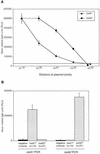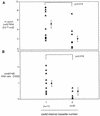Quantitative detection of Helicobacter pylori gene expression in vivo and relationship to gastric pathology
- PMID: 10992444
- PMCID: PMC101496
- DOI: 10.1128/IAI.68.10.5488-5495.2000
Quantitative detection of Helicobacter pylori gene expression in vivo and relationship to gastric pathology
Abstract
The iceA locus of Helicobacter pylori includes one of two mutually exclusive gene families, iceA1 and iceA2. Colonization with iceA1 strains is associated with enhanced acute mucosal inflammation, and adherence to gastric epithelial cells in vitro induces expression of iceA1 but not iceA2 mRNA; however, both transcripts can be detected in vivo. The aim of this study was to determine whether differing levels of iceA transcription in vivo may contribute to disease pathogenesis. RNA from 41 H. pylori-positive gastric biopsy specimens was reverse transcribed to cDNA. Quantitative PCR was performed using biotinylated iceA1, iceA2, and 16S rRNA primers, and binding of biotinylated products to streptavidin-coated plates was detected by hybridization with a fluorescein-labeled probe. iceA genotypes were determined by PCR and sequence analysis. All 41 samples contained detectable H. pylori 16S rRNA, with similar levels in iceA1- (n = 10) and iceA2 (n = 31)-colonized patients (P = 0.34). Biopsy specimens from four (40%) and 19 (61%) persons colonized with iceA1 or iceA2 strains, respectively, had detectable iceA RNA. Acute inflammatory scores were significantly higher in iceA1 RNA-positive patients than in iceA1 RNA-negative, iceA2 RNA-positive, or iceA2 RNA-negative subjects (P </= 0.05 for each). Within the iceA2 RNA-positive group, H. pylori strains with a single 35-amino-acid cassette were associated with significantly higher mucosal iceA2 transcript levels (P = 0.014 versus strains with two cassettes). These results indicate that the levels of transcription of H. pylori iceA1 and iceA2 and of 16S rRNA are independent and that particular iceA2 gene structures are associated with enhanced transcription. The finding that iceA1 transcription levels are significantly associated with the intensity of neutrophilic infiltration suggests that heterogeneity in inflammatory scores among persons colonized with H. pylori iceA1 strains reflects levels of iceA1 transcription in vivo.
Figures





Similar articles
-
[Investigation of Helicobacter pylori iceA1 and iceA2 genes in patients with chronic gastritis and gastric cancer].Mikrobiyol Bul. 2011 Apr;45(2):228-33. Mikrobiyol Bul. 2011. PMID: 21644065 Turkish.
-
[Infection of Helicobacter pylori strains with multiple vacA m-region subtypes and/or iceA mixed genotype among the Bai, Naxi, and Han populations in Yunnan province].Zhonghua Yi Xue Za Zhi. 2005 Sep 7;85(34):2408-13. Zhonghua Yi Xue Za Zhi. 2005. PMID: 16321248 Chinese.
-
Adherence to gastric epithelial cells induces expression of a Helicobacter pylori gene, iceA, that is associated with clinical outcome.Proc Assoc Am Physicians. 1998 Nov-Dec;110(6):531-44. Proc Assoc Am Physicians. 1998. PMID: 9824536
-
[Occurrence rate of Helicobacter pylori iceA alleles in infected patient in the Białystok Province].Przegl Epidemiol. 2008;62 Suppl 1:69-74. Przegl Epidemiol. 2008. PMID: 22329018 Polish.
-
Regulatory network of non-coding RNA in Helicobacter pylori: A systematic approach.Life Sci. 2024 Dec 15;359:123194. doi: 10.1016/j.lfs.2024.123194. Epub 2024 Oct 29. Life Sci. 2024. PMID: 39481832 Review.
Cited by
-
Multipronged regulatory functions of a novel endonuclease (TieA) from Helicobacter pylori.Nucleic Acids Res. 2016 Nov 2;44(19):9393-9412. doi: 10.1093/nar/gkw730. Epub 2016 Aug 22. Nucleic Acids Res. 2016. PMID: 27550181 Free PMC article.
-
iceA genotypes of Helicobacter pylori strains isolated from Brazilian children and adults.J Clin Microbiol. 2001 May;39(5):1746-50. doi: 10.1128/JCM.39.5.1746-1750.2001. J Clin Microbiol. 2001. PMID: 11325984 Free PMC article.
-
Relationship among oxidative DNA damage, gastric mucosal density and the relevance of cagA, vacA and iceA genotypes of Helicobacter pylori.Dig Dis Sci. 2008 Jan;53(1):248-55. doi: 10.1007/s10620-007-9850-0. Epub 2007 May 23. Dig Dis Sci. 2008. PMID: 17520364
-
Novel 180- and 480-base-pair insertions in African and African-American strains of Helicobacter pylori.J Clin Microbiol. 2004 Dec;42(12):5658-63. doi: 10.1128/JCM.42.12.5658-5663.2004. J Clin Microbiol. 2004. PMID: 15583296 Free PMC article.
-
Molecular Basis of pathogenicity in Helicobacter pylori clinical isolates.J Clin Microbiol. 2010 Oct;48(10):3776-8. doi: 10.1128/JCM.00472-10. Epub 2010 Aug 4. J Clin Microbiol. 2010. PMID: 20686086 Free PMC article.
References
-
- Akopyants N S, Clifton S W, Kersulyte D, Crabtree J E, Youree B E, Reece C A, Bukanov N O, Drazek E S, Roe B A, Berg D E. Analyses of the cag pathogenicity island of Helicobacter pylori. Mol Microbiol. 1998;28:37–53. - PubMed
-
- Alard P, Lantz O, Sebagh M, Calvo C F, Weill D, Chavanel G, Senik A, Charpentier B. A versatile ELISA-PCR assay for mRNA quantitation from a few cells. BioTechniques. 1993;15:730–737. - PubMed
-
- Atherton J C, Cao P, Peek R M, Jr, Tummuru M K, Blaser M J, Cover T L. Mosaicism in vacuolating cytotoxin alleles of Helicobacter pylori. Association of specific vacA types with cytotoxin production and peptic ulceration. J Biol Chem. 1995;270:17771–17777. - PubMed
-
- Blaser M J, Perez-Perez G I, Kleanthous H, Cover T L, Peek R M, Chyou P H, Stemmermann G N, Nomura A. Infection with Helicobacter pylori strains possessing cagA is associated with an increased risk of developing adenocarcinoma of the stomach. Cancer Res. 1995;55:2111–2115. - PubMed
Publication types
MeSH terms
Substances
Grants and funding
LinkOut - more resources
Full Text Sources
Medical

